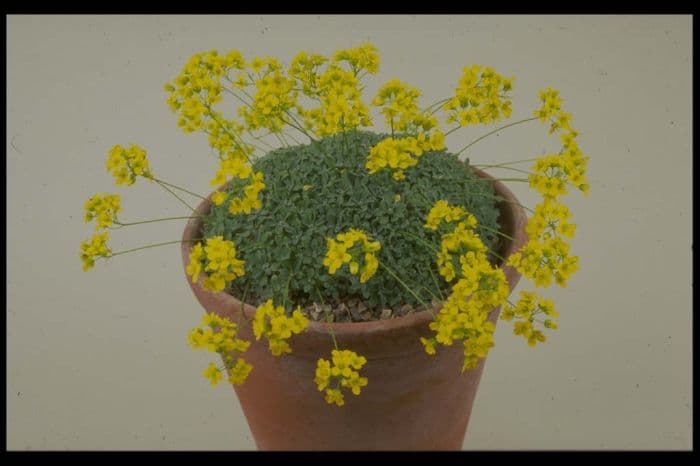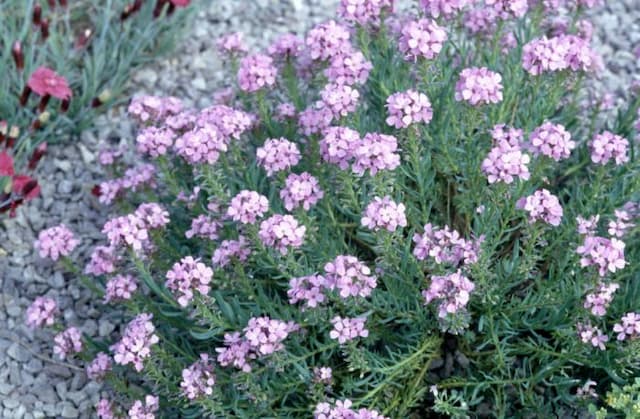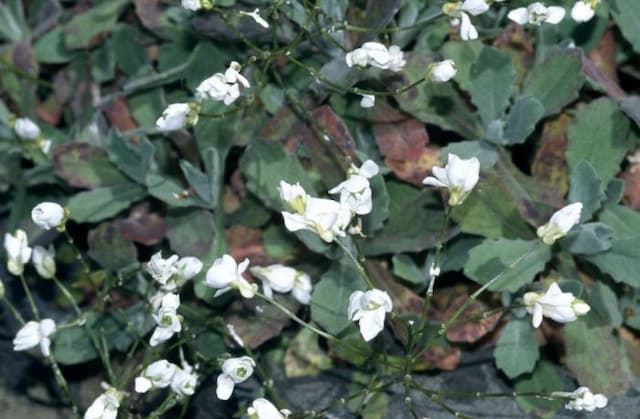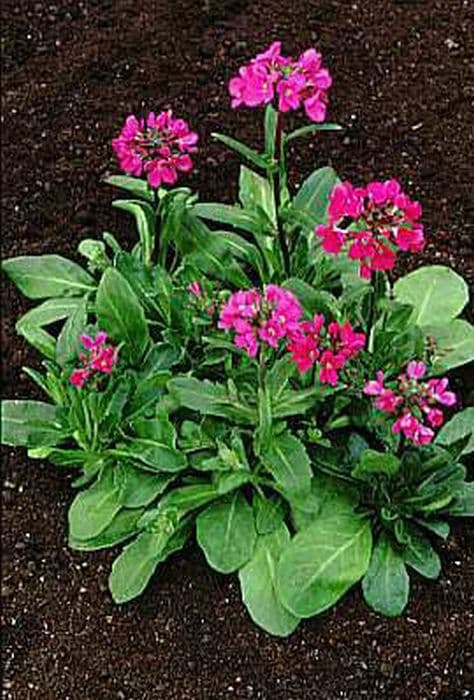Longpod draba Draba longisiliqua

ABOUT
Draba longisiliqua, commonly known as long-podded draba, is a flowering plant that exhibits a number of characteristic features. It typically has a rosette of basal leaves from which emerge one or more flowering stalks. The leaves are generally oblong to spoon-shaped and may have smooth or slightly toothed edges. They often have a hairy surface which can vary from sparse to dense depending on the individual plant. The flowering stems carry clusters of small, four-petaled white to yellowish flowers. These clusters are known as racemes and each individual flower is arranged along the stem on a short stalk. The petals are cross-shaped, a common trait within its family. After flowering, long-podded draba produces slender, elongated seed pods. These pods are held erect or spread from the axis of the stem and can be quite conspicuous compared to the small size of the individual flowers. The plant has a preference for rocky or sandy soils and is often found in alpine or other high elevation habitats where it endures cold temperatures and strong winds.
About this plant
 Names
NamesFamily
Brassicaceae
Synonyms
Long-Podded Draba, Long-Podded Whitlow Grass
Common names
Draba longisiliqua.
 Toxicity
ToxicityTo humans
Draba longisiliqua, commonly referred to as Long-pod Draba, is not widely known for its toxicity to humans. There is limited documentation or reports of this particular species being toxic or causing negative effects when touched or ingested. However, it is important to note that even in the absence of known toxicity, plants can sometimes cause allergic reactions or unanticipated effects in individuals. Therefore, it is generally advisable to avoid ingesting plants that are not commonly recognized as edible.
To pets
Draba longisiliqua, or Long-pod Draba, does not appear to have a reputation for being toxic to pets. There is a lack of specific information regarding its effects on animals if ingested. While it is not classified among commonly known poisonous plants, as a precautionary measure, it is always best to prevent pets from consuming plants not meant for their diet, as they might have individual sensitivities or allergies. If a pet ingests this plant and shows any signs of distress, consult a veterinarian.
 Characteristics
CharacteristicsLife cycle
Biennials
Foliage type
Deciduous
Color of leaves
Green
Flower color
White
Height
0.5 feet (15 cm)
Spread
0.5 feet (15 cm)
Plant type
Herb
Hardiness zones
5
Native area
Europe
Benefits
 General Benefits
General Benefits- Ecosystem support: Draba longisiliqua, commonly known as Long-fruited Draba, can provide food and habitat for pollinators, insects, and other local wildlife, contributing to biodiversity.
- Soil stabilization: The root systems of this plant can help prevent soil erosion, especially in rocky or alpine environments where Long-fruited Draba may naturally occur.
- Aesthetic value: With its small, distinctive flowers and rosettes of leaves, Long-fruited Draba can add visual interest and variety to rock gardens or alpine garden settings.
- Educational interest: As part of a native plant garden or ecological study area, Draba longisiliqua can serve as an example of local flora and provide educational opportunities for learning about plant life cycles and identification.
- Adaptability: Long-fruited Draba is typically capable of thriving in poor soil conditions where other plants may struggle, making it a suitable choice for challenging garden spots or revegetation projects.
 Medical Properties
Medical PropertiesThis plant is not used for medical purposes.
 Air-purifying Qualities
Air-purifying QualitiesThis plant is not specifically known for air purifying qualities.
 Other Uses
Other Uses- Draba longisiliqua, commonly known as Long-pod Draba, can be cultivated in rock gardens for its adaptability to rocky and sandy substrates, providing an aesthetic quality to xeric landscapes.
- In specialized butterfly gardens, Long-pod Draba can be included as it may serve as a host plant for specific butterfly and moth larvae, contributing to the conservation of these species.
- Long-pod Draba can function as a ground cover for sloped areas to help prevent soil erosion with its root system.
- This plant's presence in wildflower meadows can increase the biodiversity of the area, supporting various species of native insects and small animals.
- Due to its small and manageable size, Long-pod Draba could be used in miniature and fairy garden designs as they replicate larger landscapes on a diminutive scale.
- The species might be used in educational settings such as school gardens to teach students about alpine and arctic ecosystems where this plant is commonly found.
- As an alpine plant, Long-pod Draba may be used in climate change studies to assess the impact of temperature changes on mountainous vegetation.
- Gardeners could use this plant as an indicator species for overwatering, as it thrives in well-drained soils, and any sign of wilting could suggest excessive moisture.
- Though not known for being particularly aromatic, Long-pod Draba could play a minor role in sensory gardens focusing on texture and visual diversity.
- For artists and photographers, the plant can provide an intriguing subject in alpine or macro photography due to its tiny flowers and intricate form.
Interesting Facts
 Feng Shui
Feng ShuiThe plant Draba longisiliqua is not used in Feng Shui practice.
 Zodiac Sign Compitability
Zodiac Sign CompitabilityThe plant Draba longisiliqua is not used in astrology practice.
 Plant Symbolism
Plant Symbolism- Resilience: Draba longisiliqua, commonly known as Longpod Draba, often grows in rocky, challenging environments, symbolizing the ability to thrive in difficult conditions.
- Persistence: This plant's ability to spread and persist in tough terrains is symbolic of persistence and determination in life's endeavors.
- Adaptability: Longpod Draba's variety in habitats from lowlands to alpine regions represents adaptability and versatility in various situations.
- Simplicity: With its small size and unassuming appearance, Longpod Draba is often associated with the beauty of simplicity and modesty.
- Purity: The white to yellowish flowers of Longpod Draba can symbolize purity and innocence, reflecting its clean, simple aesthetic.
 Water
WaterThe Long-Stalked Draba requires well-drained soil and should be watered sparingly, avoiding waterlogging. It is best to water the plant when the top inch of the soil feels dry to the touch, which typically means watering approximately once a week, depending on the environment's humidity and temperature. As a rule of thumb, provide the Long-Stalked Draba with about 8 ounces of water every watering session, ensuring consistency in the watering schedule to maintain the plant's health.
 Light
LightLong-Stalked Draba thrives best in full sunlight to partial shade conditions. The ideal spot for this plant is a location where it can receive at least six hours of direct sunlight each day, although it can tolerate some light shade during the hottest part of the afternoon. Ensure the plant has ample light without being exposed to scorching midday sun.
 Temperature
TemperatureLong-Stalked Draba prefers cool to moderate temperature ranges and can usually withstand temperatures as low as 20°F and as high as 80°F. The ideal temperature for this plant ranges from 50°F to 70°F. It is important not to place the Long-Stalked Draba in areas where the temperature can drop below 20°F or rise above 80°F for prolonged periods.
 Pruning
PruningPruning Long-Stalked Draba is essential to remove dead or damaged growth and to maintain its shape. Prune early in the spring as new growth appears to encourage bushier growth. This plant does not typically require frequent pruning; doing so once a year is usually adequate. The best time for pruning is right after it blooms if you wish to control its size or maintain a dense growth habit.
 Cleaning
CleaningAs needed
 Soil
SoilThe Longpod Draba thrives in a well-draining gritty mix with a slightly acidic to neutral pH of about 6.0 to 7.0. A suitable soil mix could be a combination of sand, loamy soil, and peat, ensuring quick drainage and preventing water-logging.
 Repotting
RepottingLongpod Draba does not frequently require repotting; it can be done every 2-3 years or when it has clearly outgrown its current container.
 Humidity & Misting
Humidity & MistingLongpod Draba prefers low to moderate humidity levels, making it suitable for typical indoor environments without the need for additional humidity adjustments.
 Suitable locations
Suitable locationsIndoor
Place Longpod Draba in bright light and avoid overwatering.
Outdoor
Plant in well-drained soil with full sun to partial shade.
Hardiness zone
4-8 USDA
 Life cycle
Life cycleDraba longisiliqua, commonly known as Long-podded Draba, begins its life cycle as a seed, which upon germination in suitable conditions, develops into a small rosette of leaves close to the ground. This rosette stage is a vegetative phase where the plant establishes itself, gathering resources through photosynthesis. As it matures, Long-podded Draba enters the reproductive phase, sending up flowering stalks that bear small white flowers arranged in clusters. After pollination, these flowers develop into elongated seed pods, which is a characteristic feature reflected in the common name. Seeds are eventually dispersed from the mature pods by wind, water, or animal activity, leading to the colonization of new areas. The plant is an annual or biennial, completing its full cycle from seed to seed production within one or two growing seasons, respectively.
 Propogation
PropogationPropogation time
Spring to Summer
The most popular method of propagation for Draba longisiliqua, commonly known as Longpod Draba, is through seed sowing. Seeds can usually be sown in the fall directly into a well-draining, cold frame or in the spring after the last frost has passed. If sowing in the spring, seeds often benefit from stratification, which is a process of cold treatment to break the seed’s dormancy. To stratify, seeds should be mixed with moist sand and placed in a plastic bag, which is then kept in the refrigerator at about 40 degrees Fahrenheit (4.4 degrees Celsius) for about 2 to 4 weeks. After stratifying, seeds are sown on the surface of a seed-starting mix and lightly covered with soil, as they require light for germination. Maintaining an even moisture level and providing bright, indirect light will help facilitate germination. Seedlings can be transplanted to their final location once they have developed a few true leaves and there is no longer a risk of frost.







![Aubrieta [Axcent Burgundy]](/_next/image?url=https%3A%2F%2Fplants-admin.emdemapps.com%2Fimages%2Fplants%2F%2Fimages%2F604b5b7b548d8.png&w=640&q=75)

